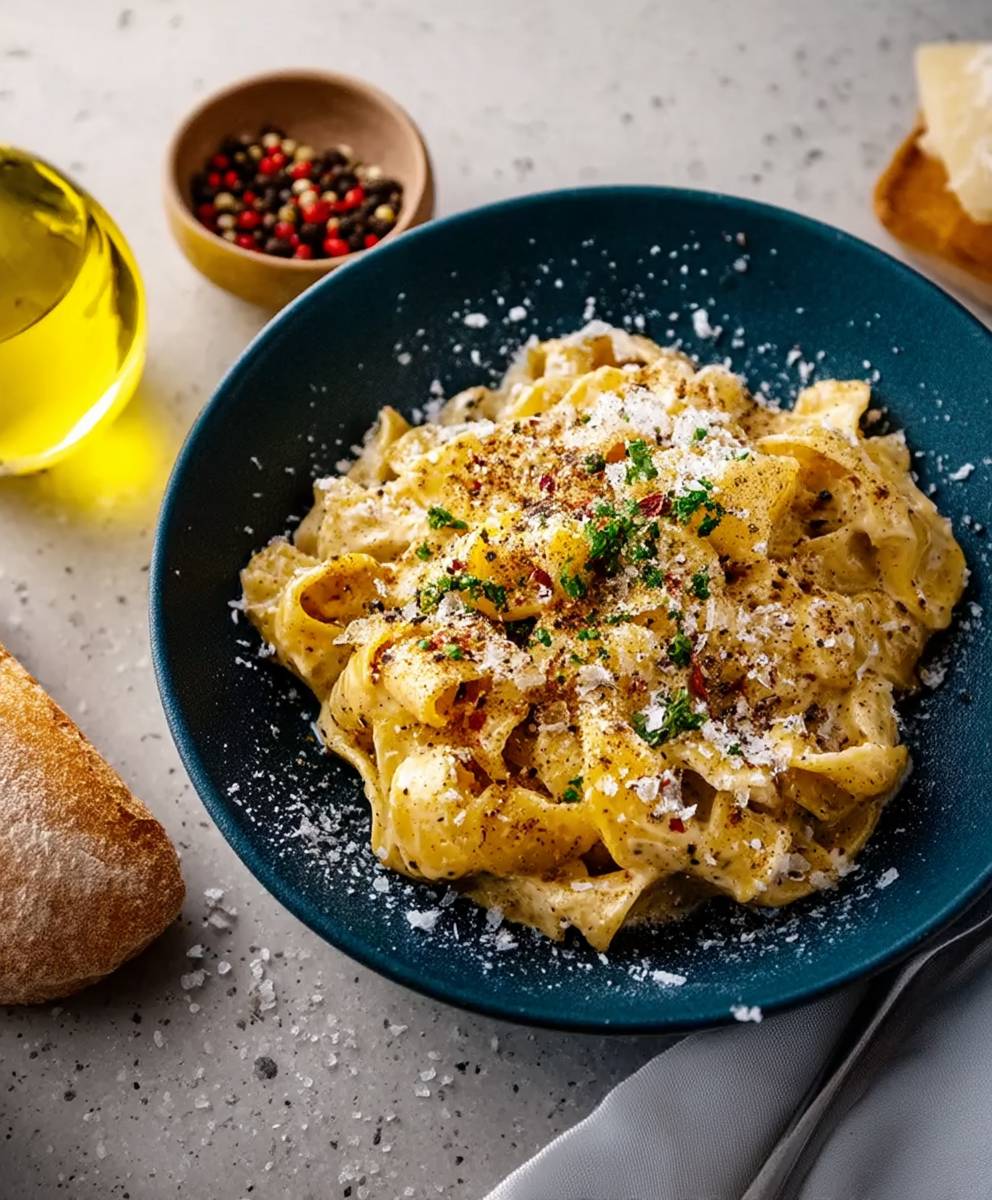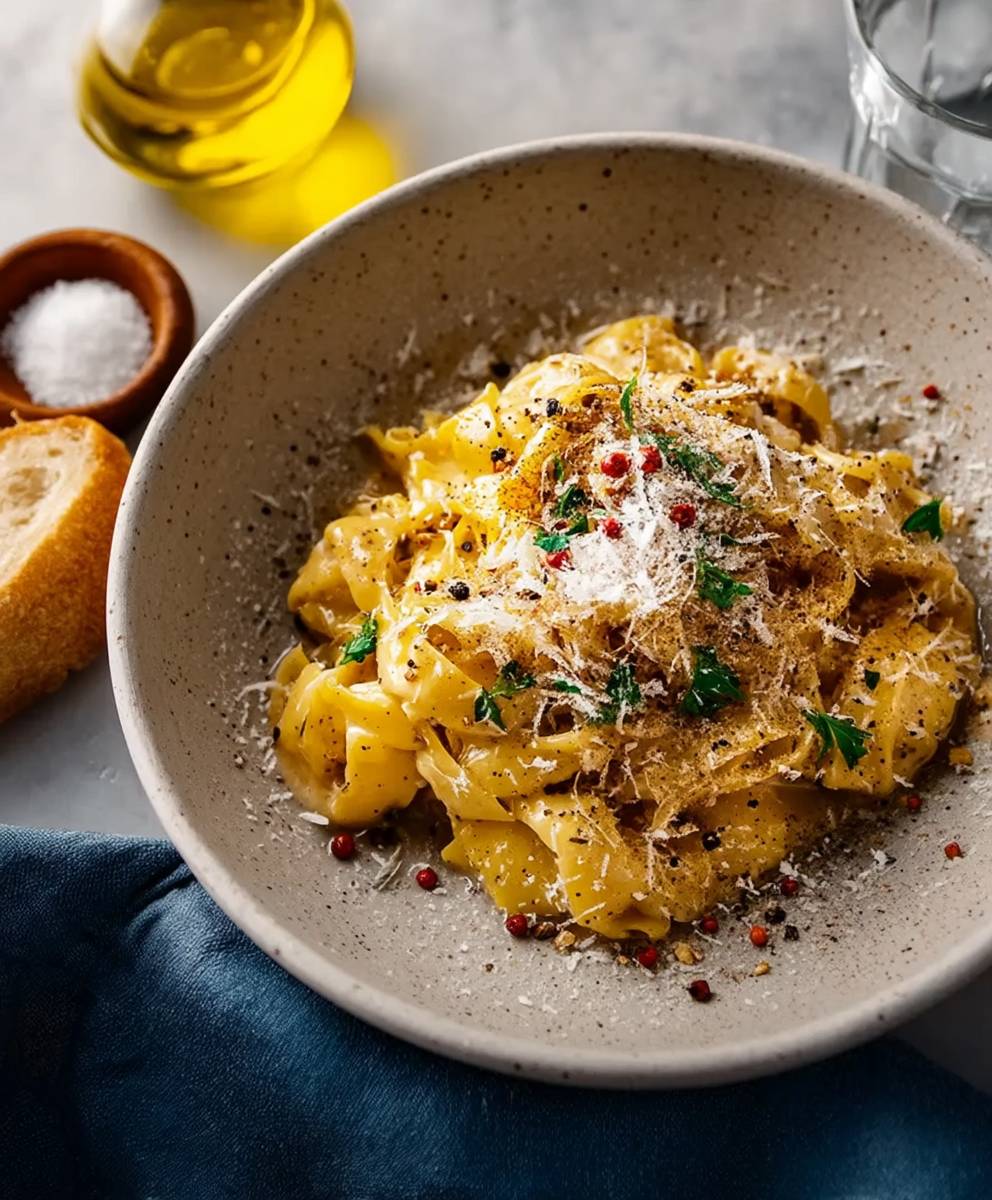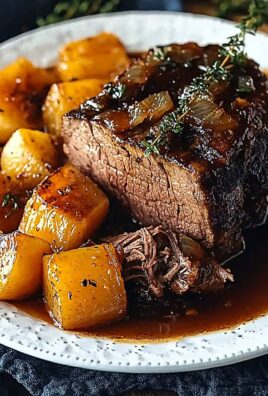Cacio e Pepe Pasta: Prepare to be amazed by the sheer simplicity and profound deliciousness of this Roman classic! Have you ever encountered a dish that requires only four ingredients yet delivers an explosion of flavor with every single bite? That’s the magic of Cacio e Pepe. This isn’t just pasta; it’s an experience, a testament to the power of quality ingredients and masterful technique.
Originating in Rome, Italy, Cacio e Pepe translates to “cheese and pepper” in the local dialect, which perfectly encapsulates its essence. Shepherds in the Roman countryside are credited with its creation, relying on readily available ingredients like Pecorino Romano cheese and black pepper. It was a nourishing and easily transportable meal, fueling them through long days tending their flocks. This humble beginning has blossomed into a globally loved dish, gracing the menus of both Michelin-starred restaurants and cozy home kitchens.
So, why is Cacio e Pepe Pasta so universally adored? It’s the perfect marriage of creamy, sharp Pecorino Romano cheese, the pungent bite of freshly cracked black pepper, and perfectly cooked pasta, all emulsified into a luscious sauce with starchy pasta water. The creamy texture is incredibly satisfying, and the bold flavors are both comforting and exciting. Plus, its quick preparation time makes it an ideal weeknight meal. Who can resist a restaurant-quality pasta dish ready in under 20 minutes? Let’s dive into creating this culinary masterpiece together!
Ingredients:
- 1 pound (450g) spaghetti, preferably bronze-die
- 4 ounces (115g) Pecorino Romano cheese, finely grated (about 1 1/2 cups, packed)
- 2-3 teaspoons freshly cracked black pepper, plus more to taste
- 2 tablespoons unsalted butter
- 1/2 cup reserved pasta water, plus more as needed
- Salt, to taste (be mindful of the saltiness of the Pecorino)
Preparing the Cheese and Pepper Mixture:
Okay, let’s get started! The key to a truly amazing Cacio e Pepe is all in the preparation. We need to get our cheese and pepper ready to mingle before the pasta even thinks about being cooked.
- Grate the Pecorino Romano: This is crucial. Use a fine grater, like a microplane or the fine side of a box grater. You want the cheese to be almost like a powder. This will help it melt smoothly into the sauce. Don’t skimp on the cheese! It’s the star of the show.
- Crack the Black Pepper: Freshly cracked black pepper is non-negotiable. The pre-ground stuff just won’t cut it. Use a pepper grinder or, even better, crack the peppercorns with a mortar and pestle for the most intense flavor. Aim for a coarse grind, but not too chunky. We want that peppery bite, but not to be chewing on pepper pieces.
- Combine Cheese and Pepper: In a medium bowl, combine the grated Pecorino Romano and the freshly cracked black pepper. Mix them together thoroughly. This ensures that the pepper is evenly distributed throughout the cheese, which will help create a balanced flavor in the final dish. Set this mixture aside.
Cooking the Pasta:
Now, let’s get that pasta cooking! Remember, we want perfectly al dente pasta, as it will continue to cook slightly in the sauce.
- Bring Water to a Boil: Fill a large pot with plenty of water (at least 6 quarts). Add a generous amount of salt. The water should taste like the sea! This seasons the pasta from the inside out. Bring the water to a rolling boil over high heat.
- Cook the Spaghetti: Add the spaghetti to the boiling water and cook according to the package directions, but subtract about 1-2 minutes from the recommended cooking time. We want the pasta to be al dente, meaning it should still have a slight bite to it. This is important because the pasta will continue to cook in the sauce, and we don’t want it to become mushy.
- Reserve Pasta Water: Before draining the pasta, reserve at least 1 cup of the pasta water. This starchy water is liquid gold! It’s essential for creating the creamy, emulsified sauce that makes Cacio e Pepe so special. I usually scoop out a cup and set it aside before draining the rest of the water.
- Drain the Pasta: Drain the pasta quickly, but don’t rinse it! We want to keep that starchy coating on the pasta, as it will help the sauce cling to it.
Creating the Cacio e Pepe Sauce:
This is where the magic happens! The key to a smooth, creamy sauce is to work quickly and carefully, using the heat of the pasta and the starchy water to emulsify the cheese and pepper.
- Melt the Butter: While the pasta is cooking, melt the butter in a large skillet over medium-low heat. You don’t want the butter to brown, just melt it gently.
- Add Pasta to the Skillet: Add the drained pasta to the skillet with the melted butter. Toss the pasta to coat it evenly with the butter.
- Add Cheese and Pepper Mixture: Remove the skillet from the heat. This is important! If the skillet is too hot, the cheese will clump up and become stringy. Gradually add the cheese and pepper mixture to the pasta, tossing constantly with tongs. Add a little bit of the cheese mixture at a time, making sure it’s evenly distributed and starts to melt.
- Add Pasta Water: Add a splash of the reserved pasta water to the skillet. Continue tossing the pasta vigorously. The pasta water will help to emulsify the cheese and create a creamy sauce. Add more pasta water, a tablespoon or two at a time, until the sauce reaches your desired consistency. You want it to be creamy and cling to the pasta, but not watery.
- Continue Tossing: Keep tossing the pasta constantly, adding more pasta water as needed, until the cheese is completely melted and the sauce is smooth and creamy. This process requires a bit of patience and a lot of tossing! Don’t be afraid to add more pasta water if the sauce seems too dry.
- Adjust Seasoning: Taste the sauce and adjust the seasoning as needed. You may need to add a little more salt, but be mindful of the saltiness of the Pecorino Romano. You can also add more freshly cracked black pepper to taste.
Serving the Cacio e Pepe:
Now for the best part enjoying your delicious Cacio e Pepe!
- Serve Immediately: Cacio e Pepe is best served immediately, while the sauce is still hot and creamy. The sauce can thicken as it cools, so don’t let it sit for too long.
- Garnish (Optional): If you like, you can garnish the Cacio e Pepe with a sprinkle of extra grated Pecorino Romano and a generous grind of fresh black pepper.
- Enjoy! Serve the Cacio e Pepe in warm bowls and enjoy every delicious bite! This simple yet elegant dish is sure to impress.
Troubleshooting Tips:
Sometimes, even with the best intentions, things can go a little sideways. Here are some common issues and how to fix them:
- Clumpy Sauce: If your sauce becomes clumpy, it’s likely because the skillet was too hot when you added the cheese. Try adding a little more pasta water and tossing vigorously to help the cheese melt smoothly. You can also try removing the skillet from the heat completely and adding the cheese in very small increments, tossing constantly.
- Watery Sauce: If your sauce is too watery, it’s likely because you added too much pasta water. Try cooking the sauce over low heat for a minute or two to allow some of the excess water to evaporate. You can also add a little more grated Pecorino Romano to help thicken the sauce.
- Bland Flavor: If your Cacio e Pepe tastes bland, it’s likely because you didn’t use enough salt or pepper. Be sure to season the pasta water generously and add plenty of freshly cracked black pepper to the sauce. You can also add a pinch of red pepper flakes for a little extra heat.
- Pasta is Overcooked: If your pasta is overcooked and mushy, there’s not much you can do to fix it. Be sure to cook the pasta al dente, as it will continue to cook in the sauce. Next time, subtract even more time from the package directions.
Variations:
While Cacio e Pepe is traditionally a very simple dish, there are a few variations you can try to add your own personal touch:
- Add Guanciale: For a richer, more flavorful dish, try adding crispy guanciale (cured pork cheek). Cook the guanciale in the skillet before adding the butter, and then proceed with the recipe as directed.
- Add a Touch of Cream: For an even creamier sauce, you can add a tablespoon or two of heavy cream to the skillet along with the pasta water. This is not traditional, but it can add a nice richness to the dish.
- Use Different Pasta Shapes: While spaghetti is the most traditional pasta shape for Cacio e Pepe, you can also use other long pasta shapes like bucatini or tonnarelli.
- Add Lemon Zest: A little bit of lemon zest can add a bright, citrusy note to the dish. Add the lemon zest to the skillet along with the cheese and pepper mixture.
Tips for Success:
Here are a few final tips to help you make the perfect Cacio e Pepe:
- Use High-Quality Ingredients: The quality of your ingredients will make a big difference in the final dish. Use good-quality spaghetti, freshly grated Pecorino Romano cheese, and freshly cracked black pepper.
- Don’t Overcook the Pasta: Be sure to cook the pasta al dente, as it will continue to cook in the sauce.
- Work Quickly:

Conclusion:
This Cacio e Pepe Pasta recipe is more than just a meal; it’s an experience. It’s a testament to the fact that sometimes, the simplest things in life are truly the best. The creamy, peppery sauce clinging to perfectly cooked pasta is an absolute delight, and the minimal ingredients mean you can whip this up any night of the week. It’s quick, satisfying, and guaranteed to impress, even if you’re just impressing yourself!
Why is this a must-try? Because it’s a masterclass in flavor balance. The sharp Pecorino Romano cheese, the pungent black pepper, and the starchy pasta water come together in a symphony of taste and texture that will leave you craving more. It’s also incredibly versatile. While the classic recipe is divine on its own, there are so many ways to customize it to your liking.
Looking for serving suggestions? A simple green salad with a light vinaigrette is the perfect accompaniment to cut through the richness of the pasta. You could also add a sprinkle of toasted breadcrumbs for extra crunch. For a heartier meal, consider serving it alongside grilled chicken or shrimp.
And speaking of variations, the possibilities are endless! If you’re feeling adventurous, try adding a pinch of red pepper flakes for a touch of heat. Some people like to incorporate a knob of butter for extra richness, but I find the pasta water does a fantastic job of creating a creamy sauce on its own. You could also experiment with different types of pasta. While spaghetti is traditional, bucatini or tonnarelli would also work beautifully. For a vegetarian twist, consider adding roasted vegetables like asparagus or zucchini. If you are feeling particularly decadent, a poached egg on top elevates this simple dish to something truly special.
But honestly, the beauty of this Cacio e Pepe Pasta lies in its simplicity. Don’t overthink it! Just focus on using high-quality ingredients and following the instructions carefully. The key is to work quickly and confidently to create that perfect emulsified sauce.
I truly believe that everyone should have this recipe in their repertoire. It’s a lifesaver on busy weeknights, a crowd-pleaser for dinner parties, and a comforting indulgence whenever you need a little pick-me-up.
So, what are you waiting for? Grab your ingredients, put on some music, and get cooking! I’m confident that you’ll fall in love with this classic Italian dish.
And most importantly, I want to hear about your experience! Did you try any variations? Did you encounter any challenges? What did you think of the final result? Share your photos and stories in the comments below. I can’t wait to see what you create! Happy cooking! Let me know if you have any questions, I’m always happy to help. This Cacio e Pepe is a recipe you’ll make again and again, I promise!
Cacio e Pepe Pasta: The Authentic Recipe and Expert Tips
Simple Roman pasta with spaghetti, Pecorino Romano, and black pepper. Creamy, cheesy, and delicious!
Ingredients
- 1 pound (450g) spaghetti, preferably bronze-die
- 4 ounces (115g) Pecorino Romano cheese, finely grated (about 1 1/2 cups, packed)
- 2-3 teaspoons freshly cracked black pepper, plus more to taste
- 2 tablespoons unsalted butter
- 1/2 cup reserved pasta water, plus more as needed
- Salt, to taste (be mindful of the saltiness of the Pecorino)
Instructions
- Prepare Cheese and Pepper: In a medium bowl, combine the finely grated Pecorino Romano cheese and freshly cracked black pepper. Mix thoroughly and set aside.
- Cook Pasta: Bring a large pot of salted water to a rolling boil. Add spaghetti and cook according to package directions, subtracting 1-2 minutes for al dente.
- Reserve Pasta Water: Before draining, reserve at least 1 cup of pasta water.
- Drain Pasta: Drain the pasta quickly, without rinsing.
- Melt Butter: While pasta cooks, melt butter in a large skillet over medium-low heat.
- Add Pasta to Skillet: Add the drained pasta to the skillet with melted butter and toss to coat.
- Add Cheese and Pepper Mixture: Remove the skillet from the heat. Gradually add the cheese and pepper mixture to the pasta, tossing constantly with tongs until evenly distributed and starting to melt.
- Add Pasta Water: Add a splash of reserved pasta water to the skillet. Continue tossing vigorously. Add more pasta water, a tablespoon or two at a time, until the sauce reaches your desired consistency.
- Adjust Seasoning: Taste and adjust seasoning as needed. Add more salt (carefully) or black pepper to taste.
- Serve Immediately: Serve Cacio e Pepe immediately in warm bowls. Garnish with extra grated Pecorino Romano and fresh black pepper, if desired.
Notes
- Cheese Grating: Use a fine grater (microplane or fine side of a box grater) for the Pecorino Romano to ensure it melts smoothly.
- Pepper: Freshly cracked black pepper is essential for the best flavor.
- Pasta Water: The starchy pasta water is crucial for creating a creamy, emulsified sauce. Don’t skip it!
- Temperature Control: Removing the skillet from the heat before adding the cheese is important to prevent clumping.
- Tossing: Constant tossing is key to emulsifying the cheese and creating a smooth sauce.
- Troubleshooting:
- Clumpy Sauce: Add more pasta water and toss vigorously.
- Watery Sauce: Cook over low heat to evaporate excess water or add more cheese.
- Bland Flavor: Add more salt and pepper.
- Variations:
- Add crispy guanciale.
- Add a touch of heavy cream.
- Use different pasta shapes (bucatini, tonnarelli).
- Add lemon zest.





Leave a Comment